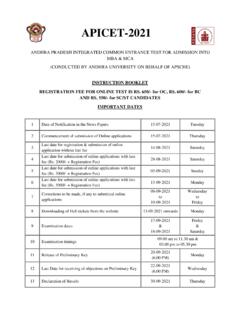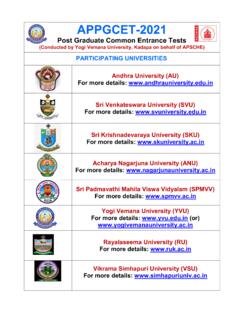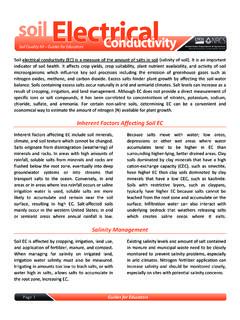Transcription of SUBJECT: BOTANY Botany-I: Intermediate First Year
1 SUBJECT: BOTANY BOTANY -I: Intermediate First Year UNIT-I:DIVERSITY IN THE LIVING WORLD: 1. The living world: What is living? Diversity in the living world; Taxonomic categories and taxonomical aids. 2. Biological Classification: Five kingdom classification - Monera, Protista, Fungi, Plantae and Animalia, Three domains of life (six kingdom classification), Viruses, Viroids, Prions & Lichens. 3. Science of plants BOTANY : Origin, Development, Scope of BOTANY and Branches of BOTANY . 4. Plant Kingdom: Salient features, classification and alternation of generations of the plants of the following groups - Algae, Bryophytes, Pteridophytes, Gymnosperms and Angiosperms.
2 UNIT-II:STRUCTURAL ORGANISATION IN PLANTS- MORPHOLOGY: 5. Morphology of flowering Plants: Vegetative: Parts of a typical Angiospermic plant; Vegetative morphology and modifications- Root, Stem and Leaf- types; Venation, : Inflorescence - Racemose, Cymose and special types (in brief). Flower: Parts of a flower and their detailed description; Aestivation, Placentation. Fruits: Types- True, False and parthenocarpic fruits. UNIT-III:REPRODUCTION IN PLANTS: 6. Modes of Reproduction: A sexual reproduction, binary fission, Sporulation, budding, fragmentation, vegetative propagation in plants, Sexual reproduction-in brief, Overview of angiosperm life cycle.
3 7. Sexual Reproduction in Flowering Plants: Stamen, microsporangium, pollen grain. Pistil, megasporangium (ovule) and embryo sac; Development of male and female gametophytes. Pollination - Types, agents, Out breeding devices and Pollen - Pistil interaction. Double Fertilization; Post fertilisation events: Development of endosperm and embryo; development of seed, Structure of Dicotyledonous and Monocotyledonous seeds, Significance of fruit and seed. Special modes - Apomixis, parthenocarpy, polyembryony. UNIT-IV:PLANT SYSTEMATICS: 8. Taxonomy of angiosperms: Introduction. Types of Systems of classification (In brief).
4 Semi- Technical description of a typical flowering plant. Description of Families: Fabaceae, Solanaceae and Liliaceae. UNIT-V:CELL STRUCTURE AND FUNCTION: 9. Cell- The Unit of Life: Cell- Cell theory and cell as the basic unit of life- overview of the cell. Prokaryotic and Eukoryotic cells, Ultra Structure of Plant cell (structure in detail and functions in brief), Cell membrane, Cell wall, Cell organelles: Endoplasmic reticulum, Mitochondria, Plastids, Ribosomes, Golgi bodies, Vacuoles, Lysosomes, Microbodies, Centrosome and Centriole, Cilia, Flagella, Cytoskeleton and Nucleus. Chromosomes: Number, structural organization; Nucleosome.
5 10. Biomolecules: Structure and function of Proteins, Carbohydrates, Lipids and Nucleic acids. 11. Cell cycle and Cell Division: Cell cycle, Mitosis, Meiosis - significance. UNIT-VI:INTERNAL ORGANISATION OF PLANTS: 12. Histology and Anatomy of Flowering Plants: Tissues - Types, structure and functions: Meristematic; Permanent tissues - Simple and Complex tissues. Tissue systems - Types, structure and function: Epidermal, Ground and Vascular tissue systems. Anatomy of Dicotyledonous and Monocotyledonous plants - Root, Stem and Leaf. Secondary growth in Dicot stem and Dicot root. UNIT-VII:PLANT ECOLOGY: 13. Ecological Adaptations, Succession and Ecological Services: Introduction.
6 Plant communities and Ecological adaptations: Hydrophytes, Mesophytes and Xerophytes. Plant succession. Ecological services-Carbon fixation, Oxygen release and pollination (in brief). BOTANY -II: Intermediate Second Year UNIT-I:PLANT PHYSIOLOGY 1. Transport in Plants: Means of Transport- Diffusion, Facilitated Diffusion, Passive symports and antiports, Active Transport, Comparison of Different Transport Processes, Plant-Water Relations- Water Potential, Osmosis, Plasmolysis, Imbibition, Long Distance Transport of Water- Water Movement up a Plant, Root Pressure, Transpiration pull, Transpiration- Opening and Closing of Stomata, Transpiration and Photosynthesis - a compromise Uptake and Transport of Mineral Nutrients- Uptake of Mineral Ions, Translocation of Mineral Ions, Phloem transport.
7 Flow from Source to Sink-The Pressure Flow or Mass Flow Hypothesis. 2. Mineral Nutrition: Methods to Study the Mineral Requirements of Plants, Essential Mineral Elements-Criteria for Essentiality, Macronutrients, Micronutrients, Role of Macro- and Micronutrients, Deficiency Symptoms of Essential Elements, Toxicity of Micronutrients, Mechanism of Absorption of Elements, Translocation of Solutes, Soil as Reservoir of Essential Elements, Metabolism of Nitrogen-Nitrogen Cycle, Biological Nitrogen Fixation, Symbiotic nitrogen fixation, Nodule Formation. 3. Enzymes: Chemical Reactions, Enzymatic Conversions, Nature of Enzyme Action, factors affecting Enzyme Activity, Temperature and pH, Concentration of Substrate, Classification and Nomenclature of Enzymes, Co- factors .
8 4. Photosynthesis in Higher Plants: Early Experiments, Site of Photosynthesis, Pigments Involved in Photosynthesis, Light Reaction, The Electron Transport-Splitting of Water, Cyclic and Noncyclic Photo-phosphorylation, Chemiosmotic Hypothesis, Biosynthetic phase- The Primary Acceptor of CO2, The Calvin Cycle, The C4 Pathway, Photorespiration, factors affecting Photosynthesis. 5. respiration of Plants: Cellular respiration , Glycolysis, Fermentation, Aerobic respiration - Tricarboxylic Acid Cycle, Electron Transport System (ETS) and Oxidative Phosphorylation, The Respiratory Balance Sheet, Amphibolic Pathway, Respiratory Quotient.
9 6. Plant Growth and Development: Growth- Plant Growth, Phases of Growth, Growth Rates, Conditions for Growth, Differentiation, Dedifferentiation and Redifferentiation, Development, Plant Growth Regulators- Discovery, PhysiologicalEffectsofPlant Growth Regulators, Auxins,Gibberellins, Cytokinins, Ethylene, Abscisic acid, Seed Dormancy, Photoperiodism, Vernalisation UNIT-II:MICROBIOLOGY: 7. Bacteria: Morphology of Bacteria, Bacterial cell structure - Nutrition, Reproduction-Sexual Reproduction, Conjugation, Transformation, Transduction, The importance of Bacteria to Humans. 8. Viruses: Discovery, Classification of Viruses, structure of Viruses, Multiplication of Bacteriophages The lytic cycle, The Lysogenic Cycle, Viral diseases in Plants, Viral diseases in Humans.
10 UNIT-III:GENETICS: 9. Principles of Inheritance and Variation: Mendel s Experiments, Inheritance of one gene (Monohybrid Cross)-Back cross and Test cross, Law of Dominance, Law of Segregation or Law of purity of gametes, Deviations from Mendelian concept of dominance - Incomplete Dominance, Co-dominance, Explanation of the concept of dominance, Inheritance of two genes- Law of Independent Assortment, Chromosomal Theory of Inheritance, Linkage and Recombination, Mutations, Significance of mutations. UNIT-IV:MOLECULAR BIOLOGY: 10. Molecular Basis of inheritance: The DNA- Structure of Polynucleotide Chain, Packaging of DNA-Helix.






